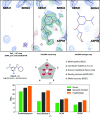FragMAX: the fragment-screening platform at the MAX IV Laboratory
- PMID: 32744259
- PMCID: PMC7397489
- DOI: 10.1107/S205979832000889X
FragMAX: the fragment-screening platform at the MAX IV Laboratory
Abstract
Advances in synchrotron storage rings and beamline automation have pushed data-collection rates to thousands of data sets per week. With this increase in throughput, massive projects such as in-crystal fragment screening have become accessible to a larger number of research groups. The quality of support offered at large-scale facilities allows medicinal chemistry-focused or biochemistry-focused groups to supplement their research with structural biology. Preparing the experiment, analysing multiple data sets and prospecting for interesting complexes of protein and fragments require, for both newcomers and experienced users, efficient management of the project and extensive computational power for data processing and structure refinement. Here, FragMAX, a new complete platform for fragment screening at the BioMAX beamline of the MAX IV Laboratory, is described. The ways in which users are assisted in X-ray-based fragment screenings and in which the fourth-generation storage ring available at the facility is best exploited are also described.
Keywords: BioMAX; FragMAX; drug discovery; fragment screening; high-throughput data analysis; protein crystallography; software; user facility.
open access.
Figures





References
-
- Carr, R. A. E., Congreve, M., Murray, C. W. & Rees, D. C. (2005). Drug Discov. Today, 10, 987–992. - PubMed
-
- Cipriani, F., Röwer, M., Landret, C., Zander, U., Felisaz, F. & Márquez, J. A. (2012). Acta Cryst. D68, 1393–1399. - PubMed
-
- Congreve, M., Carr, R., Murray, C. & Jhoti, H. (2003). Drug Discov. Today, 8, 876–877. - PubMed
-
- Davies, T. G. & Tickle, I. J. (2011). Top. Curr. Chem. 317, 33–59. - PubMed
-
- Douangamath, A., Fearon, D., Gehrtz, P., Krojer, T., Lukacik, P., Owen, C. D., Resnick, E., Strain-Damerell, C., Aimon, A., Ábrányi-Balogh, P., Brandaõ-Neto, J., Carbery, A., Davison, G., Dias, A., Downes, T. D., Dunnett, L., Fairhead, M., Firth, J. D., Jones, S. P., Keely, A., Keserü, G. M., Klein, H. F., Martin, M. P., Noble, M. E. M., O’Brien, P., Powell, A., Reddi, R., Skyner, R., Snee, M., Waring, M. J., Wild, C., London, N., von Delft, F. & Walsh, M. A. (2020). bioRxiv, 2020.05.27.118117.
MeSH terms
Substances
Grants and funding
LinkOut - more resources
Full Text Sources

